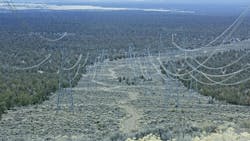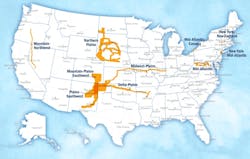DOE Announces Initial List of High-Priority Areas for Accelerated Transmission Expansion
The U.S. Department of Energy (DOE) has released a preliminary list of 10 potential National Interest Electric Transmission Corridors (NIETCs) to accelerate the development of transmission projects in areas requiring an urgent expanded transmission.
DOE also announced minimum eligibility criteria for direct loans under the Transmission Facility Financing (TFF) program. The TFF program helps finance the development of transmission projects in designated NIETCs and is supported by President Biden’s Investing in America agenda.
Currently, DOE is looking for public input on both the preliminary list of potential NIETCs and the TFF program application and evaluation process.
A NIETC designation offers critical federal financing and permitting tools for transmission development, including direct loans through the TFF program, public-private partnerships through the Transmission Facilitation Program, and Federal siting and permitting authority of the Federal Energy Regulatory Commission (FERC) in certain limited circumstances.
Developers and state and local siting authorities may also be able to leverage the environmental analysis conducted by DOE as part of the NIETC designation process to complete local siting and permitting processes, which are expected to accelerate siting and permitting for transmission projects in these targeted, high-priority areas.
DOE released final guidance on NIETC designation in December 2023 and initiated a four-phase process by inviting interested parties to suggest specific geographic areas where a NIETC designation may be helpful in advancing transmission to meet the regional need. DOE’s preliminary list of potential NIETCs included 10 narrow geographic areas covering nine of the regions identified by DOE’s 2023 National Transmission Needs Study.
The potential NIETCs:
- Include one or more potential transmission projects currently under development whose deployment could be accelerated by the tools unlocked by NIETC designation.
- Range in width from less than one mile to near 100 miles and in length from 12 to 780 miles.
- Often parallel existing rights of way such as state highways and high-voltage transmission lines.
- Have the potential to facilitate the integration of renewable energy resources such as wind and solar, including offshore wind generation in the Atlantic Ocean.
- Present the opportunity to increase transmission capacity between the Eastern and Western Interconnections--two otherwise largely disconnected grids.
- The preliminary list includes maps of each potential NIETC. The maps should be viewed as rough approximations. The geographic boundaries of any potential NIETC that continues in the designation process may ultimately differ from what is presented in the preliminary list. Today’s announcement is not designating any final NIETC.
The announcement starts Phase 2 of the NIETC designation process, including opening a 45-day window for public comments on the geographic boundaries and potential impacts of NIETC designation on environmental, community, and other resources.
Following Phase 2, DOE will prioritize the potential NIETCs to move from the preliminary list to Phase 3, during which the agency will draft NIETC designation reports, conduct environmental reviews, proceed with government-to-government consultation with any impacted Tribal Nations as appropriate, and engage in robust public engagement.
DOE anticipates announcing the narrowed list of potential NIETCs and initiating Phase 3 in the fall of 2024. DOE is currently looking for public input on the scope of eligible projects and project financing requirements, including feedback from utilities and project developers interested in receiving direct loan support through the TFF program for a specific project in or near one of the potential NIETCs.
About the Author
T&D World Staff
Content Team
Nikki Chandler
Group Editorial Director, Energy
[email protected]
Jeff Postelwait
Managing Editor
[email protected]
Christina Marsh
Senior Editor
[email protected]
Ryan Baker
Associate Editor
[email protected]
Amy Fischbach
Electric Utility Operations
[email protected]
Rich Maxwell
Community Editor
[email protected]
Gene Wolf
Technical Editor
[email protected]

